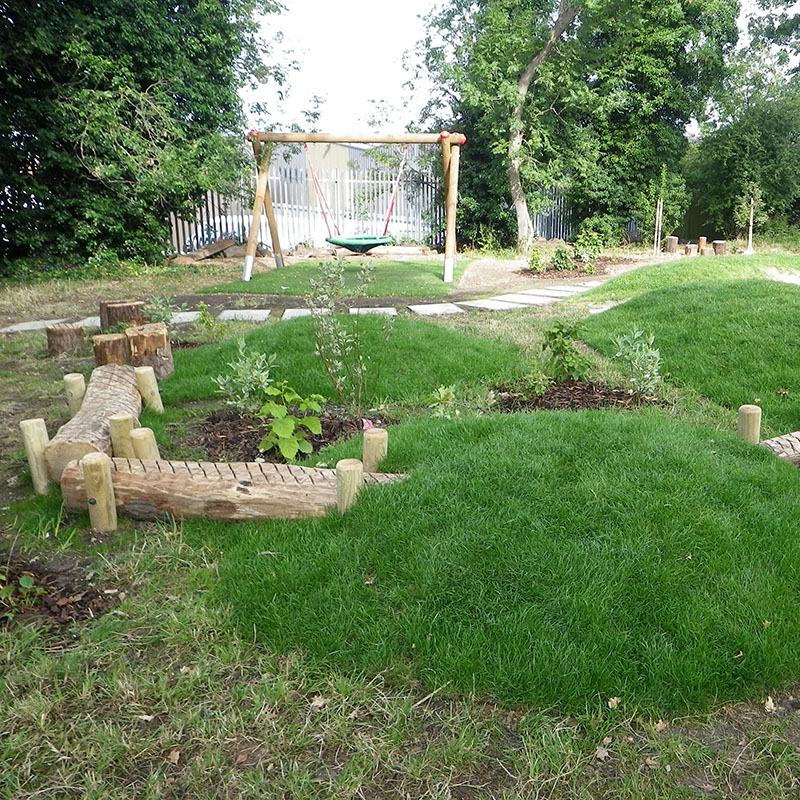Play Naturally, Thrive Uniquely: Exploring the Magic of Natural Playgrounds
Part one of a multi-part article on the magic and benefits of natural playgrounds.

In an increasingly digital age, a world where kids spend a lot of time on screens, playing outside is more important than ever. Natural playgrounds give kids the perfect antidote, offering wholesome, immersive experiences, they are special places where kids can have fun, learn, and make friends.
They’re full of exciting things to explore, and they’re built to fit right into the natural world around them. Well-thought-out design, ingenuity, and respect for the natural environment, these playgrounds breathe new life into outdoor spaces, transforming them into exciting spaces for exploration and growth.
At Theories Landscapes, our core belief is that every child should have a not only a safe and fun place to play, but the opportunity to experience the rich wonders of nature while indulging in playful exploration. That’s why specialise in the design and build of natural playgrounds – that kids everywhere, love. Blending seamlessly into their surroundings, our playgrounds include elements like trees, rocks, and water features to make our playgrounds as fun and natural as possible while encouraging imaginative and active play. Our goal is to make outdoor play a part of every child’s life.
What is a Natural Playground?
Natural playgrounds, also known as nature play areas or adventure playgrounds, are outdoor play environments specifically designed to incorporate natural elements and materials that are typically found in nature. Unlike traditional playgrounds that often feature standardised equipment and structures, natural playgrounds prioritise the use of natural materials such as logs, rocks, sand, water, and plants.
These playgrounds are intentionally created to provide children with opportunities to engage in unstructured play and exploration, encouraging them to connect with the natural world. Natural playgrounds offer a departure from the structured and prescribed play experiences commonly found in traditional playgrounds, allowing children to use their imagination, creativity, and problem-solving skills in a more open-ended and natural environment.
In natural playgrounds, children are encouraged to interact with the elements and materials in a self-directed manner, building, digging, climbing, balancing, and engaging in imaginative play. These play areas often feature a variety of play elements, such as climbing structures made from logs or boulders, balance beams, swings, slides, and areas for digging, building, and imaginative play.
The primary goal of natural playgrounds is to provide a safe and stimulating environment where children can develop physically, socially, and emotionally while connecting with nature. These playgrounds aim to promote healthy child development by offering opportunities for physical activity, fostering creativity, enhancing cognitive skills, reducing stress, and encouraging social interaction.
Natural playgrounds are gaining popularity as they align with the growing understanding of the importance of nature-based experiences and play in a child’s life. By incorporating natural elements, these play areas provide children with unique opportunities to explore, learn, and develop skills in a setting that encourages a deeper connection with the natural world.
Importance of natural playgrounds for children’s development :
Play holds immense significance in a child’s life as it serves as a fundamental medium for their overall development. Through play, children acquire and refine essential physical, cognitive, social, and emotional skills. Natural playgrounds, with their focus on unstructured play and incorporation of natural elements, offer unique benefits that go beyond what traditional playgrounds can provide.
Holistic Development:
Play is crucial for holistic development as it engages children in various activities that stimulate different aspects of their growth. Natural playgrounds facilitate this development by providing opportunities for physical, cognitive, social, and emotional engagement in a natural and immersive environment.
Connection with Nature:
Natural playgrounds offer a valuable opportunity for children to establish a meaningful connection with the natural world. Unlike traditional playgrounds that often isolate children from nature, natural playgrounds immerse them in an environment filled with trees, plants, rocks, and other natural elements. This connection with nature promotes environmental awareness, fosters a sense of stewardship, and helps children develop an appreciation for the natural world.
Multi-Sensory Stimulation:
Natural playgrounds engage multiple senses, offering a rich and diverse sensory experience for children. They can touch different textures, smell the earthy scents, hear the rustling of leaves, and observe the changing colours of the environment. This multi-sensory stimulation enhances their sensory perception, cognitive processing, and sensory integration skills.
Risk and Challenge:
Natural playgrounds often provide opportunities for children to take appropriate risks and face challenges. Unlike traditional playgrounds with standardized equipment, natural playgrounds offer uneven terrains, climbing structures with varying levels of difficulty, and natural elements that require problem-solving skills. This exposure to manageable risks and challenges helps children develop resilience, confidence, and problem-solving abilities.
Imaginative and Creative Play:
Natural playgrounds offer an environment conducive to imaginative and creative play. The presence of natural materials like logs, rocks, and tree stumps encourages children to transform them into imaginative props, fostering storytelling, role-playing, and creative exploration. This type of play supports cognitive development, language skills, and nurtures their imagination.
Free and Unstructured Play:
Natural playgrounds provide an open-ended and unstructured play environment. Unlike traditional playgrounds that often dictate the specific activities children should engage in, natural playgrounds allow for self-directed, child-led play experiences. This freedom and autonomy promote self-expression, decision-making, and problem-solving, allowing children to shape their own play experiences based on their interests and abilities.
Well-being and Mental Health:
Spending time in natural environments has been shown to have positive effects on children’s well-being and mental health. Natural playgrounds offer a serene and calming atmosphere, allowing children to unwind, reduce stress, and experience a sense of tranquillity. The combination of nature and play fosters a positive emotional state, promotes relaxation, and contributes to overall mental well-being.
By embracing the principles of nature-based play, natural playgrounds provide children with unique and invaluable opportunities for holistic development, environmental connection, imaginative play, and well-being. These benefits set them apart from traditional playgrounds and emphasise the importance of incorporating nature into children’s play experiences.
Promoting Physical Activity
Engaging in regular physical activities offers numerous benefits for their health, well-being, and overall development. Natural playgrounds provide a diverse range of physical activities that cater to children’s interests and abilities, encouraging movement, exercise, and active play. These activities not only improve their physical fitness but also contribute to the development of gross motor skills. In this section, we will explore the benefits of physical activity, the range of activities offered by natural playgrounds, and how these playgrounds specifically improve children’s gross motor skills.
Benefits of Physical Activity for Children’s Growth and Development
Physical activity plays a vital role in the overall growth and development of children. Regular engagement in physical activities offers numerous benefits for their health and well-being. It helps to:
- Improve cardiovascular health and stamina.
- Enhance muscular strength and endurance.
- Support healthy bone development.
- Maintain a healthy body weight.
- Develop coordination, balance, and agility.
- Enhance cognitive function and academic performance.
- Boost mood and emotional well-being.
Range of Physical Activities Offered by Natural Playgrounds
Natural playgrounds provide a diverse range of physical activities that cater to children’s varying interests and abilities. These activities promote movement, exercise, and active play. Some examples include:
- Climbing: Natural playgrounds often feature structures such as tree stumps, boulders, or wooden climbing frames that encourage children to climb and conquer different heights and challenges.
- Balancing: Natural elements like logs, balance beams, or stepping stones provide opportunities for children to practice and improve their balance and coordination skills.
- Jumping: Natural playgrounds may include mounds or natural terrain that children can jump off or over, promoting leg strength and coordination.
- Crawling: Tunnels, low-lying branches, or crawling spaces in natural playgrounds allow children to engage in crawling activities that strengthen their upper body and core muscles.
- Running: Open spaces within natural playgrounds provide ample room for children to run freely, promoting cardiovascular fitness and overall physical endurance.
Natural playgrounds also offer a balance between structured and unstructured physical play. While some elements provide specific challenges and activities, the overall design allows children to explore and create their own physical play experiences based on their interests and capabilities. This unstructured play encourages children to develop their own ideas, problem-solving skills, and creativity in how they engage with the natural environment.
How Natural Playgrounds Improve Gross Motor Skills
Engaging in physical activities within natural playgrounds helps children develop and refine their gross motor skills, which involve the movement and coordination of large muscle groups. Natural playgrounds contribute to the improvement of gross motor skills in several ways:
- Climbing structures and obstacles require children to use their arms, legs, and core muscles to navigate different surfaces and heights, enhancing strength and coordination.
- Balancing activities on logs, stepping stones, or uneven terrain challenge children to develop stability and control over their body movements.
- Jumping activities promote lower body strength and coordination, as children learn to coordinate their leg muscles to achieve a successful jump.
- Crawling through tunnels or under branches helps develop upper body strength and coordination.
- Running in open spaces allows children to practice running, sprinting, and changing directions, improving their overall speed, agility, and endurance.
By providing a wide range of physical activities and opportunities for both structured and unstructured play, natural playgrounds actively promote physical movement, exercise, and the development of gross motor skills in children. These activities contribute to their overall physical fitness, coordination, and well-being.
In this first part of our multi-part article on natural playgrounds we have introduced you to the concept and the playgrounds importance in children’s development, help promote physical activities and improving motor skills.
In our next article in the series we’ll be looking at how natural playgrounds foster creativity and imagination, enhance cognitive development and reduce stress and anxiety.
